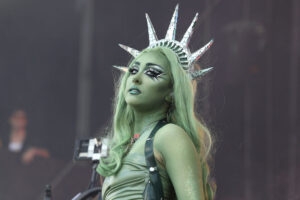Finding myself at a birthday party for much younger celebrants this weekend, I felt a wraith among the living. My life’s ambition to look like Michelle Pfeiffer had finally been realised — only it was the Stardust Pfeiffer, a 5,000-year-old witch, who stared back at me in the bathroom mirror.
I tried my best to blend in, but one moment in particular exposed the jig. Amid a hellish game involving ping pong balls and cups of flat Carling, a ripple went through the crowd and everybody started to act out choreo from a video I’d definitely scrolled past. I racked my faltering memory: I’d heard this song before, diced into infuriating snippets on social media. TikTok crack. A blonde apparition entered my mind: Sabrina Carpenter, the befringed, “Espresso”-crooning doll inflicted with Fifties swimming-costume outfits by an army of corporate promoters. Barry Keoghan’s erstwhile gf.
It rocks me to my core that these slick 23-year-olds, not yet ravaged by the horrors of 25, think this is cool — or, at least, don’t care whether it is or not. We insufferable elder Gen Zs are usually fiercely resistant to such mainstream intrusions, wanging on about Nick Drake and pretending we never liked One Direction (I swear I never did). But looking around me, I had to ask: has TikTok finally killed music?
Sabrina Carpenter is the latest Venus to emerge from the great Disney clam. To extend this shaky metaphor, she has emerged from the severed testicles of a hit Disney Channel sitcom, Girl Meets World. She barely existed six months ago, but with the help of two hits and a relationship scandal — Keoghan supposedly ditched his ex and baby for Carpenter, the rat! — she is now front and centre. Her music is extremely polished, the performances perfected for vertical TikTok filming. She is shiny and new, with a distinctive haircut and a glowy face. And she has a new album out, Short and Sweet, which might as well be about the diminutive but amiable Barry.
Observers outside the fanbase would be forgiven for thinking Carpenter and her ilk are all a bit, well, samey. But there has always been an element of fakery to the cult of pop stars; in the Sixties, EMI had teenage girls believing John Lennon didn’t have a wife (who he continually beat up). We like to think of the golden age of rock as an army of absolutely original geniuses inventing new sounds every day — but we forget the imitation bands history has kindly forgotten, not least the teenybopper flops (the Cyrkle, the Knickerbockers, the Beau Brummels). Yes, there was less filler and more terrible teeth, but the record label image-polishing was absolutely the same.
Even the news that Oasis are getting the band back together after 15 years of bitter feuding is not the “antidote” it may seem. The Gallaghers themselves shamelessly ripped off the Beatles with added simian swag; and though their original albums represent a rough-hewn, more interesting provenance than anything a former Disney star could conjure up, this “massive” tour is likely to be as corporate as they come.
And yet, we are much more accepting of trades in blokey nostalgia than in girly, attention-seeking glamour, though this is probably down to keenly felt snobberies about different calibres of fans. The Oasis Man and the Disney Girl couldn’t be further apart in terms of cultural prestige; one is a discerning and hard-bitten gig-goer, the other little more than a receptacle for glossy makeup products and plasticky tunes. But there is nothing exceptional about liking a band which dominated the charts for more than a decade, and for which middle-aged bores tune into Chris Moyles on Radio X. Besides, the vices of scruffy rock stars haven’t been shocking since the Seventies — whereas the dark arts of big studios are worthy of the name.
Disney is in the habit of belching out stars like Sabrina. Britney Spears, Justin Timberlake, Christina Aguilera, Miley Cyrus, Demi Lovato, Selena Gomez — there is a surfeit of once-new kids on the block, still kicking about in West Hollywood like ageing teenagers. The formula is thus: five to 10 years of mainstream success with a few earworm hits, then a rocky patch (Justin and Britney break up, Britney goes bald, Christina and Demi gain weight, Selena gets some alleged immune disease which miraculously has the same effect as a boatload of facial filler). Then they are left to either drift, becoming sad phantoms of their former selves (see Amanda Bynes of Nickelodeon, or Justin’s inglorious mugshot after allegedly drink-driving in June) or redeemed, continually recreating their foetal pop star look (43-year-old Christina Aguilera’s recent re-teenifying makeover is nothing short of witchcraft).
The way we lap up these creations is so routine now as to be unremarkable. But for the teenage girls plucked into stardom, this process involves signing an unspoken deal with your loving public: you must remain a teenager for as long as you can. Taylor Swift, whose never-ending Eras tour finally wrapped up in London last week, is 34: she’s been on the scene since about 2006, beginning as a curly-haired country singer, warbling about trucks and princesses and the like. Now, at the height of her powers, there’s a quality of Blanche DuBois about her. A grown woman, she has spent the past innumerable months singing about long-ago break-ups to millions of teenage girls who haven’t yet had their braces off. She is forced to replay the heartbreaks of her tender years again and again, courting an image of vulnerability which in no way befits the steamrolling corporate machine she now represents.
Part of this performance of teenagedom involves recruiting younger versions of herself as support acts: Olivia Rodrigo and Sabrina Carpenter have both appeared on the tour. In doing so, these artists are often accused of being industry plants, which is not strictly fair as to be plants they must come out of nowhere. Child stars are, by definition, already celebrities in their own right. But they certainly represent the decline of independent artists: most of them do not play instruments or write their own music or lyrics, but instead have embraced the TikTok music factory. As Paula Harper, a musicologist from the University of Chicago, told me: “Creators are thinking about making a song that has really audible, clear lip-syncable lyrics that are both weird, but can also be applied to a variety of settings.”
This system enforces a kind of creative dogma; even the most left-field talents never end up producing entirely whacky, inaccessible music. Consider Chappell Roan, the 26-year-old singer with a crimson-haired “drag” persona and a six-month-old career as a bona fide megastar. She has a startlingly original look compared to most TikTok-friendly singers; though her music has the sheen of homogenising big-studio production, her “performance art” is genuinely novel — something she confirmed by emerging from a giant apple as Lady Liberty at this year’s Governors Ball in New York, complete with assless chaps and what appeared to be a spliff.
Yet Roan is simultaneously a blend of self-conscious artifice — the costumed garishness of drag — and authentic vulnerability. Last week, she went viral for a lengthy confessional post in which she, fairly graciously and understandably, bemoaned weird stalker fans. Social media did not sympathise: the new contract between fans and artists expects the latter to sacrifice any sense of safety or privacy because “you asked for this”, a haunting argument when trained on a woman. More than anything, our idols must be grateful.
This, then, is what awaits the Gen Z celebrity: fame, money, psycho fans and public breakdowns. And for women, there’s an extra kicker: the Disney machine bestows on them the curse of perpetual adolescence, which petrifies its princesses in a state of girlhood.
What’s new about the Sabrina Carpenters of this world, though, is that women for the first time have accrued the obsession-inducing power of a lone rock god without the need to involve men. Older female icons — Aretha, Madonna, Mariah — held some broad appeal; though love-centric, their music would not embarrass a sample or feature with a male artist. Now, the top female performers, the Swifts-in-waiting, are guardians of “girlhood” and resist even an appeal to gay men. Corporate pop has finally passed the Bechdel Test. The feminisation of the charts is complete. And as no doubt we’ll discover next summer, the division between Oasis Man and Disney Girl is irrevocable, crystallised in the diverging masses queuing to see American princesses or grungy Mancunians at Wembley.
“Imagine waiting 15 years for Oasis to reform,” wrote one snarky X user on Monday, “only to lose out on tickets to Chloe, 21 from Stockport who just wants to hear Wonderwall live.” Stick to your frilly pop, girls — we free-thinking individuals have Brewdog, bucket hats and bus passes to boot, and we aren’t afraid to use them!
Disclaimer
Some of the posts we share are controversial and we do not necessarily agree with them in the whole extend. Sometimes we agree with the content or part of it but we do not agree with the narration or language. Nevertheless we find them somehow interesting, valuable and/or informative or we share them, because we strongly believe in freedom of speech, free press and journalism. We strongly encourage you to have a critical approach to all the content, do your own research and analysis to build your own opinion.
We would be glad to have your feedback.
Source: UnHerd Read the original article here: https://unherd.com/



